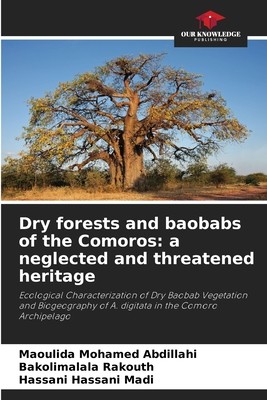
- We will send in 10–14 business days.
- Author: Maoulida Mohamed Abdillahi
- Publisher: Our Knowledge Publishing
- ISBN-10: 6206209571
- ISBN-13: 9786206209577
- Format: 15.2 x 22.9 x 0.9 cm, softcover
- Language: English
- SAVE -10% with code: EXTRA
Dry forests and baobabs of the Comoros (e-book) (used book) | bookbook.eu
Reviews
Description
Two of the world's eight known baobab species are found in the Comoros Archipelago. No in-depth study of the ecological characterization of the dry vegetation and the geographical distribution of these baobabs has yet been carried out. Some authors hypothesize that the dry plant formations of the Comoros Archipelago possess characteristic species and affinities with the flora of Madagascar and Africa, and that the baobabs of the Comoros were introduced by man; others favour a natural origin of the baobabs by sea. In order to provide answers to these questions, an identification and ecological characterization of the plant formations of Grande Comore, Mohéli and Anjouan was carried out, as well as an inventory of the baobabs in the archipelago. The floristic composition is similar to that of the dry forests and thickets of Madagascar and Africa, and the distribution of baobabs appears to be strongly related to distance from the sea, which argues in favor of a hydrochoral marine dispersion. These results should encourage better management and conservation of dry flora and vegetation.
EXTRA 10 % discount with code: EXTRA
The promotion ends in 16d.16:17:33
The discount code is valid when purchasing from 10 €. Discounts do not stack.
- Author: Maoulida Mohamed Abdillahi
- Publisher: Our Knowledge Publishing
- ISBN-10: 6206209571
- ISBN-13: 9786206209577
- Format: 15.2 x 22.9 x 0.9 cm, softcover
- Language: English English
Two of the world's eight known baobab species are found in the Comoros Archipelago. No in-depth study of the ecological characterization of the dry vegetation and the geographical distribution of these baobabs has yet been carried out. Some authors hypothesize that the dry plant formations of the Comoros Archipelago possess characteristic species and affinities with the flora of Madagascar and Africa, and that the baobabs of the Comoros were introduced by man; others favour a natural origin of the baobabs by sea. In order to provide answers to these questions, an identification and ecological characterization of the plant formations of Grande Comore, Mohéli and Anjouan was carried out, as well as an inventory of the baobabs in the archipelago. The floristic composition is similar to that of the dry forests and thickets of Madagascar and Africa, and the distribution of baobabs appears to be strongly related to distance from the sea, which argues in favor of a hydrochoral marine dispersion. These results should encourage better management and conservation of dry flora and vegetation.


Reviews